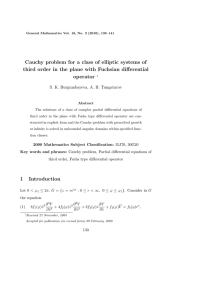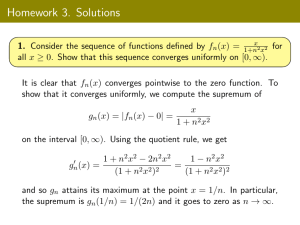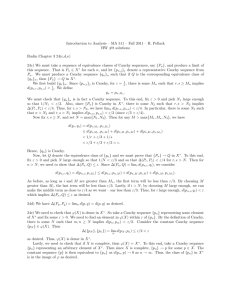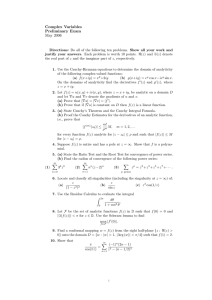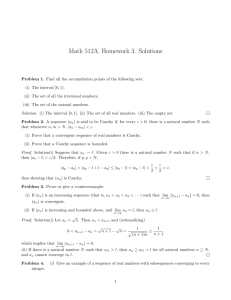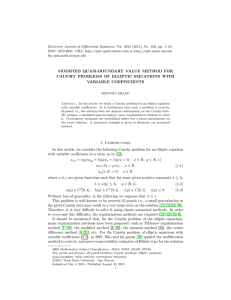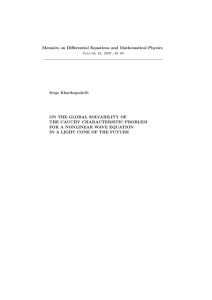Cauchy problem for a class of elliptic Fuchsian differential operator
advertisement
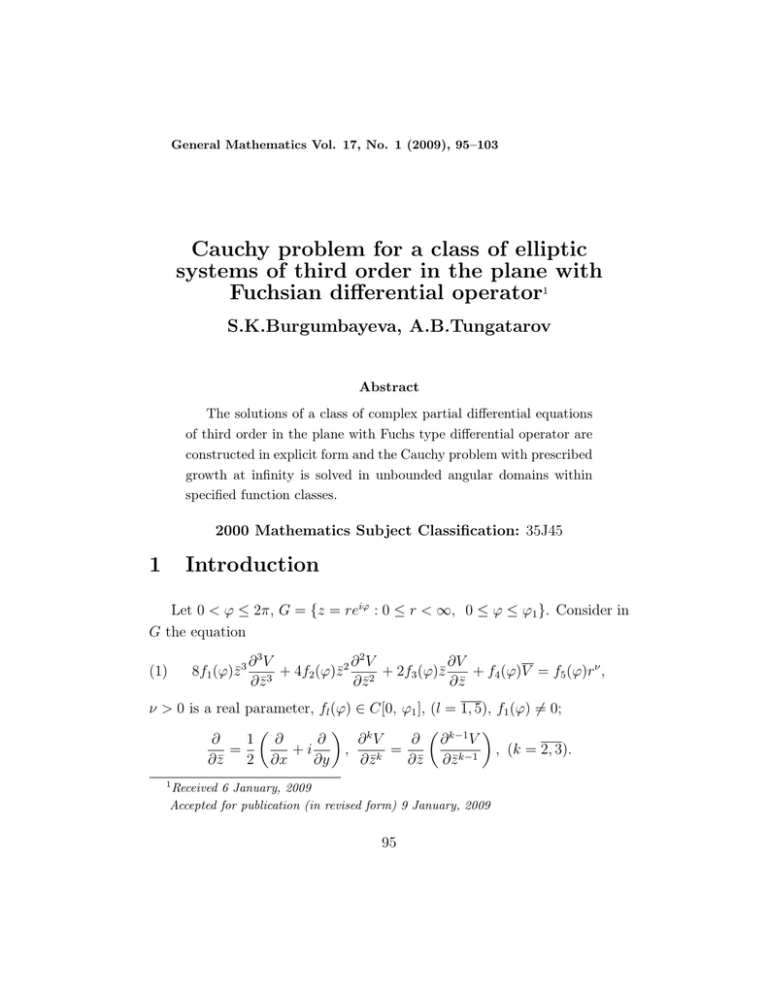
General Mathematics Vol. 17, No. 1 (2009), 95–103
Cauchy problem for a class of elliptic
systems of third order in the plane with
Fuchsian differential operator1
S.K.Burgumbayeva, A.B.Tungatarov
Abstract
The solutions of a class of complex partial differential equations
of third order in the plane with Fuchs type differential operator are
constructed in explicit form and the Cauchy problem with prescribed
growth at infinity is solved in unbounded angular domains within
specified function classes.
2000 Mathematics Subject Classification: 35J45
1
Introduction
Let 0 < ϕ ≤ 2π, G = {z = reiϕ : 0 ≤ r < ∞, 0 ≤ ϕ ≤ ϕ1 }. Consider in
G the equation
8f1 (ϕ)z̄ 3
(1)
2
∂V
∂ 3V
2∂ V
+ f4 (ϕ)V = f5 (ϕ)rν ,
+
4f
(ϕ)z̄
+ 2f3 (ϕ)z̄
2
3
2
∂ z̄
∂ z̄
∂ z̄
ν > 0 is a real parameter, fl (ϕ) ∈ C[0, ϕ1 ], (l = 1, 5), f1 (ϕ) 6= 0;
∂
1 ∂
∂
∂kV
∂ ∂ k−1 V
=
+i
,
=
, (k = 2, 3).
∂ z̄
2 ∂x
∂y
∂ z̄ k
∂ z̄ ∂ z̄ k−1
1
Received 6 January, 2009
Accepted for publication (in revised form) 9 January, 2009
95
96
S.K.Burgumbayeva, A.B.Tungatarov
Equation (1) is investigation for f1 (ϕ) ≡ 0, f2 (ϕ) ≡ const =
6 0, f3 (ϕ) ≡
const 6= 0 in [1, 2] and for f2 (ϕ) ≡ f2 (ϕ) ≡ 0, f3 ≡ const 6= 0 in [3].
2
Solutions of the equation
Using these operators in polar coordinates
∂
eiϕ ∂
i ∂
=
+
,
∂ z̄
2 ∂r r ∂ϕ
∂2
1 ∂2
2i ∂
e2iϕ ∂ 2
2i ∂ 2
1 ∂
−
−
=
+
−
,
∂ z̄ 2
4
∂r2
r ∂r∂ϕ r2 ∂ϕ2 r ∂r r2 ∂ϕ
e3iϕ ∂ 3
3i ∂ 3
3 ∂3
i ∂3
3 ∂2
9i ∂ 2
∂3
=
+
−
−
−
−
+
∂ z̄ 3
8
∂r3
r ∂r2 ∂ϕ r2 ∂ϕ2 ∂r r3 ∂ϕ3 r ∂r2 r2 ∂r∂ϕ
8i ∂
3 ∂
6 ∂2
+
+ 3 2+ 2
r ∂ϕ
r ∂r r3 ∂ϕ
equation (1) is written in the form
f1 (ϕ)r3
3
∂ 3V
∂3V
2 ∂ V
+
3if
(ϕ)r
−
3f
(ϕ)r
−
1
1
∂r3
∂r2 ∂ϕ
∂r∂ϕ2
−if1 (ϕ)
2
∂ 3V
2∂ V
+
(f
(ϕ)
−
3f
(ϕ))r
+
2
1
∂ϕ3
∂r2
(2)
(2f2 (ϕ)−9f1 (ϕ))ir
∂ 2V
∂ 2V
∂V
+(6f1 (ϕ)−f2 (ϕ)) 2 +(3f1 (ϕ)−f2 (ϕ)+f3 (ϕ))r
+
∂r∂ϕ
∂ϕ
∂r
+(8f1 (ϕ) − 2f2 (ϕ) + f3 (ϕ))i
∂V
+ f4 (ϕ)V = f5 (ϕ)rν
∂ϕ
The solutions of equation (2) are searched for in the Sobolev class [4]
Wp3 (G),
(3)
where 1 < p <
2
,
3−ν
if ν < 3 and p > 1, if ν ≥ 3.
97
Cauchy problem for a ...
One can see easily, that the function
V (r, ϕ) = rν ψ(ϕ)
(4)
represents a solution of equation (2) from class (3), if ψ(ϕ) ∈ C 3 [0, ϕ1 ] is
satisfying the equation
ψ ′′′ + a1 (ϕ)ψ ′′ + a2 (ϕ)ψ ′ + a3 (ϕ)ψ = f5 (ϕ) − f4 (ϕ)ψ,
(5)
where
a1 (ϕ) =
a2 (ϕ) =
a3 (ϕ) =
6f1 (ϕ) − f2 (ϕ) − 3νf1 (ϕ)
· i,
f1 (ϕ)
ν(9f1 (ϕ) − 2f2 (ϕ)) − 3ν(ν − 1)f1 (ϕ) − 8f1 (ϕ) + 2f2 (ϕ) − f3 (ϕ)
,
f1 (ϕ)
ν(ν − 1)(ν − 2)f1 (ϕ) + ν(ν − 1)(f2 (ϕ) − 3f1 (ϕ)) + 3f1 (ϕ) − f2 (ϕ) + f3 (ϕ)
·i
f1 (ϕ)
Let θ(ϕ) = {ψ1 (ϕ), ψ2 (ϕ), ψ3 (ϕ)} be a fundamental system of solutions of
homogeneous equation
(6)
ψ ′′′ + a1 (ϕ)ψ ′′ + a2 (ϕ)ψ ′ + a3 (ϕ)ψ = 0
Using the general solution of this equation
ψ(ϕ) = c1 ψ1 (ϕ) + c2 ψ2 (ϕ) + c3 ψ3 (ϕ),
where cl , (l = 1, 3) are arbitrary constants, in that case by applying the
method of variation of constant equation (5) becomes the integral equation
(7)
ψ(ϕ) = (Bψ)(ϕ) + cJ0 (ϕ) + G0 (ϕ),
where
Jk (ϕ) = {J1,k (ϕ), J2,k (ϕ), J3,k (ϕ)}, J1,0 (ϕ) = ψ1 (ϕ)
J2,0 (ϕ) = ψ2 (ϕ), J3,0 (ϕ) = ψ3 (ϕ), c = {c1 , c2 , c3 },
Zϕ
Zϕ
(Bψ)(ϕ) = b(ϕ, τ )ψ(τ )dτ, G0 (ϕ) = g(ϕ, τ )dτ,
0
0
98
S.K.Burgumbayeva, A.B.Tungatarov
b(ϕ, τ ) = f4 (τ ) · γ(ϕ, τ ), g(ϕ, τ ) = f5 (τ ) · γ(ϕ, τ ),
1
((ψ2 (τ )ψ3′ (τ ) − ψ3 (τ )ψ2′ (τ ))J1,0 (ϕ) − (ψ1 (τ )ψ3′ (τ )−
γ(ϕ, τ ) =
|△(ϕ)|
−ψ3 (τ )ψ1′ (τ ))J2,0 (ϕ) + (ψ1 (τ )ψ2′ (τ ) − ψ2 (τ )ψ1′ (τ ))J3,0 (ϕ)),
ψ1 ψ2 ψ3
△(ϕ) = ψ1′ ψ2′ ψ3′ , |△(ϕ)| is the determinant of the matrix △(ϕ).
ψ1′′ ψ2′′ ψ3′′
For solving equation (7) the functions and operators
Jk,j (ϕ) =
Zϕ
b(ϕ, τ )Jk,j−1 (τ )dτ, Gk (ϕ) =
0
Zϕ
b(ϕ, τ )Gk−1 (τ )dτ, (j = 1, ∞),
0
(B(B k−1 f )(ϕ))(ϕ) = (B k f )(ϕ), (k = 1, ∞), (B 0 f )(ϕ) = (Bf )(ϕ)
are used.
Applying the operator B to both sides of equation (7) gives an expression
for the function (Bf )(ϕ). Inserting it again into (7), we have
(8) ψ(ϕ) = (B3 ψ)(ϕ) + c(J0 (ϕ) + J2 (ϕ)) + cJ1 (ϕ) + G0 (ϕ) + G1 (ϕ) + G2 (ϕ),
Continuing this process 2k + 1 times, we get
(9)
ψ(ϕ) = (B
2k+1
ψ)(ϕ) + c
k
X
J2n (ϕ) + c
k
X
J2n−1 (ϕ) +
n=1
n=0
2k
X
Gn (ϕ).
n=0
As a consequence it is easy to check the inequalities
(10)
|(B k ψ)(ϕ)| ≤ |b(ϕ, τ )|k1 ·
ϕk
,
k!
|Jk, j (ϕ)| ≤ |b(ϕ, τ )|j1 ·
ϕj
,
j!
where
|b(ϕ, τ )|1 =
max |b(ϕ, τ )|.
0≤ϕ, τ ≤ϕ1
If pass to the limit as k −→ ∞ in the representations (9), by virtue (10) we
receive
(11)
ψ(ϕ) = cQ(ϕ) + cP (ϕ) + G(ϕ),
99
Cauchy problem for a ...
where
Q(ϕ) = (Q1 (ϕ), Q2 (ϕ), Q3 (ϕ)),
Qj (ϕ) =
∞
X
Jj, 2n (ϕ), Pj (ϕ) =
n=o
∞
X
P (ϕ) = (P1 (ϕ), P2 (ϕ), P3 (ϕ)),
Jj, 2n−1 (ϕ), G(ϕ) =
n=1
∞
X
Gn (ϕ), (j = 1, 3).
n=o
For these functions Qj (ϕ), Pj (ϕ), (j = 1, 3) and G(ϕ) it is easy to check
the relations
Qj (ϕ) = Jj, 0 (ϕ) +
Zϕ
b(ϕ, τ )Pj (τ )dτ,
Pj (ϕ) =
Zϕ
b(ϕ, τ )Qj (τ )dτ,
0
0
G(ϕ) = G0 (ϕ) +
Zϕ
b(ϕ, τ )G(τ )dτ,
0
(k)
Zϕ
(k)
Qj (ϕ) = ψj (ϕ) +
(k)
(k)
bϕk (ϕ, τ )Pj (τ )dτ,
Pj (ϕ) =
0
(12)
(k)
Gj (ϕ)
=
Zϕ
=
(k)
bϕk (ϕ, τ )Qj (τ )dτ,
0
(k)
gϕk (ϕ,
τ )dτ +
Zϕ
(k)
bϕk (ϕ, τ )G(τ )dτ, (k = 1, 2),
0
0
Q′′′
j (ϕ)
Zϕ
ψj′′′ (ϕ)
− f4 (ϕ)Pj (ϕ) +
Zϕ
b′′′
ϕ3 (ϕ, τ )Pj (τ )dτ,
0
Pj′′′ (ϕ)
= −f4 (ϕ)Qj (ϕ) +
Zϕ
b′′′
ϕ3 (ϕ, τ )Qj (τ )dτ,
(j = 1, 3),
0
G′′′
ϕ3 (ϕ)
= f5 (ϕ) +
Zϕ
0
gϕ′′′3 (ϕ,
τ )dτ − f4 (ϕ)G(ϕ) +
Zϕ
0
b′′′
ϕ3 (ϕ, τ )G(τ )dτ.
100
S.K.Burgumbayeva, A.B.Tungatarov
It is also easy to check the equalities
b(ϕ, ϕ) = 0,
b′ϕ (ϕ, ϕ) = 0,
b′′ϕ2 (ϕ, ϕ) = −b(ϕ),
(13)
g(ϕ, ϕ) = 0,
gϕ′ (ϕ, ϕ) = 0,
gϕ′′ (ϕ, ϕ) = f5 (ϕ)
By using formula (12) and (13) we receive the equalities
Pj′′′ (ϕ) + a1 Pj′′ (ϕ) + a2 Pj′ (ϕ) + a3 Pj (ϕ) = −f4 (ϕ)Qj (ϕ),
′
′′
Q′′′
j (ϕ) + a1 Qj (ϕ) + a2 Qj (ϕ) + a3 Qj (ϕ) = −f4 (ϕ)Pj (ϕ),
G′′′ (ϕ) + a1 G′′ (ϕ) + a2 G′ (ϕ) + a3 G(ϕ) = f5 (ϕ) − f4 (ϕ)G(ϕ).
Hence, we receive
ψ ′ (ϕ) = cθϕ′ + c
Zϕ
b′ϕ (ϕ, τ )Pj (τ )dτ + c̄
+
gϕ′ (ϕ, τ )dτ +
0
′′
ψ (ϕ) =
cθϕ′′ 2
+c
Zϕ
+
b′′ϕ2 (ϕ,
τ )Pj (τ )dτ + c̄
(14) ψ (ϕ) =
cθϕ′′′3
Zϕ
b′′ϕ2 (ϕ, τ )Qj (τ )dτ +
0
gϕ′′ 2 (ϕ, τ )dτ +
0
′′′
b′ϕ (ϕ, τ )G(τ )dτ,
0
Zϕ
0
Zϕ
b′ϕ (ϕ, τ )Qj (τ )dτ +
0
0
Zϕ
Zϕ
Zϕ
b′′ϕ2 (ϕ, τ )G(τ )dτ,
Zϕ
b′′′
ϕ3 (ϕ, τ )Pj (τ )dτ − c̄f4 (ϕ)Qj (ϕ)+
0
− cf4 (ϕ)Pj (ϕ) + c
0
+c̄
Zϕ
0
b′′′
ϕ3 (ϕ,
Zϕ
Zϕ
′′′
τ )Qj (τ )dτ +f5 (ϕ)+ gϕ3 (ϕ, τ )dτ −f4 (ϕ)G(ϕ)+ b′′′
ϕ3 (ϕ, τ )G(τ )dτ.
0
0
101
Cauchy problem for a ...
Since Jj,0 (ϕ), b(ϕ, τ ), g(ϕ, τ ) represent a solution of equation (6), then by
virtue of formula (14) we receive, that the function ψ(ϕ), given by formula
(11) is satistying equation (5).
Using inequality (10), it is easy to receive the estimates
|Qj (ϕ)| ≤ |ψj (ϕ1 )|ch(|b(ϕ, τ )|1 ),
|Pj (ϕ)| ≤ |ψj (ϕ1 )|sh(|b(ϕ, τ )|1 ),
(15)
|G(ϕ)| ≤ ϕ1 |g(ϕ, τ )|1 exp(|b(ϕ, τ )|1 ),
(j = 1, 3).
By estimate (15) we can assure that the function V (r, ϕ), given by formulas
(4), (11), is solving equation (1) in the class (3).
Thus, the following result holds:
Theorem 1. Equation (1) has a solution in the class (3), which is given
by formula (4), (11).
3
Cauchy problem
Consider the Cauchy problem with prescribed growth at infinity for system (1).
Problem C. Find a solution of equation (1) from the class (3), satisfying
the conditions
(16)
(17)
αk1 V (r, 0) + αk2
∂ 2V
∂V
(r, 0) + αk3 2 (r, 0) = βk rν ,
∂ϕ
∂ϕ
|V (r, ϕ)| = O(rν ),
(k = 1, 3)
r −→ ∞,
where akj , (k = (1, 3), j = (1, 3)) are given real numbers.
For solving problem C formulas (4), (11) are used. In that case (17) holds
automatically. The constants c1 , c2 , c3 in formula (11) are determined, in
order that the solution of equation (1), represented in the form (4) and
102
S.K.Burgumbayeva, A.B.Tungatarov
(11), satisfies condition (16). For that, insert function V (r, ϕ) according to
formulas (4), (11) into (16). Thus we receive a system of linear algebraic
equations in c1 , c2 , c3 :
(α△(0))cT = β,
(18)
where
α11 α12 α13
α = α21 α22 α23 ,
α31 α32 α33
β1
β = β2 ,
β3
c1
cT = c2
c3
Solving system (18) under |α△(0)| =
6 0, we receive
(19)
cT = (α△(0))−1 β
Thus, the following result holds:
Theorem 2. Let the roots the characteristic equation (6) be different and
different from zero. Under |α△(0)| =
6 0 the Cauchy problem has a unique
solution, which is given by formulas (4), (11) and (19).
If |α△(0)| = 0 for the solvability of the algebraic systems (18) the conditions:
(20)
|A1 | = 0,
|A2 | = 0,
|A3 | = 0
are necessary and sufficient. Here Aj ia a matrix, which is received by
replacing the i matrix column of the matrix α△(0) by the column β.
Thus, the following result holds:
Theorem 3. Let |α△(0)| = 0, then for the solvability of the Cauchy
problem the condition (20) is necessary and sufficiently. In that case the
Cauchy problem has an infinity number of solutions. They are given by
formulas (4), (11), where c is determined from equation (18) under condition
(20).
Cauchy problem for a ...
103
References
[1] S.A. Abdymanapov, Boundary problem for a class of second order elliptic systems in the quarter plane with polar singularity, Eurasian Mathematical Journal, 2006, Number 2.P.3-21 (Russian).
[2] S.A. Abdymanapov, Initial boundary problem for a class of second order
homogeneous elliptic systems in the plane with singular point, Eurasian
Mathematical Journal, 2006, Number 3. P.3-12 (Russian).
[3] S.A. Abdymanapov, A.B.Tungatarov, Some class of elliptic systems on
the plane with singular coefficients, Almaty, ”Gylym”, 2005. P.169 (Russian).
[4] I.H. Vekua, Generalized Analytic Functions, Pergamon, Oxford, 1962.
Eurasian National University
Munaitpasov st.,5 010008 Astana
KAZAKHSTAN
E-mail: tun-mat@list.ru
E-mail: saulenai@yandex.ru
